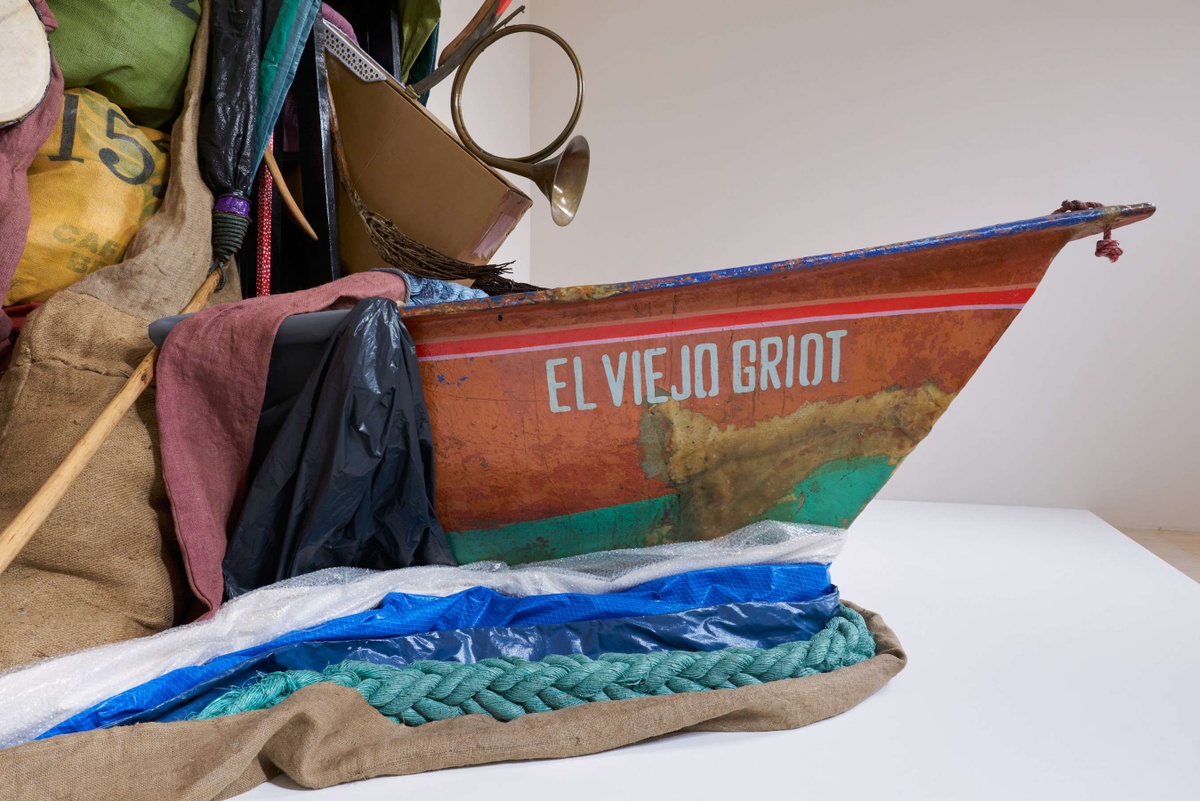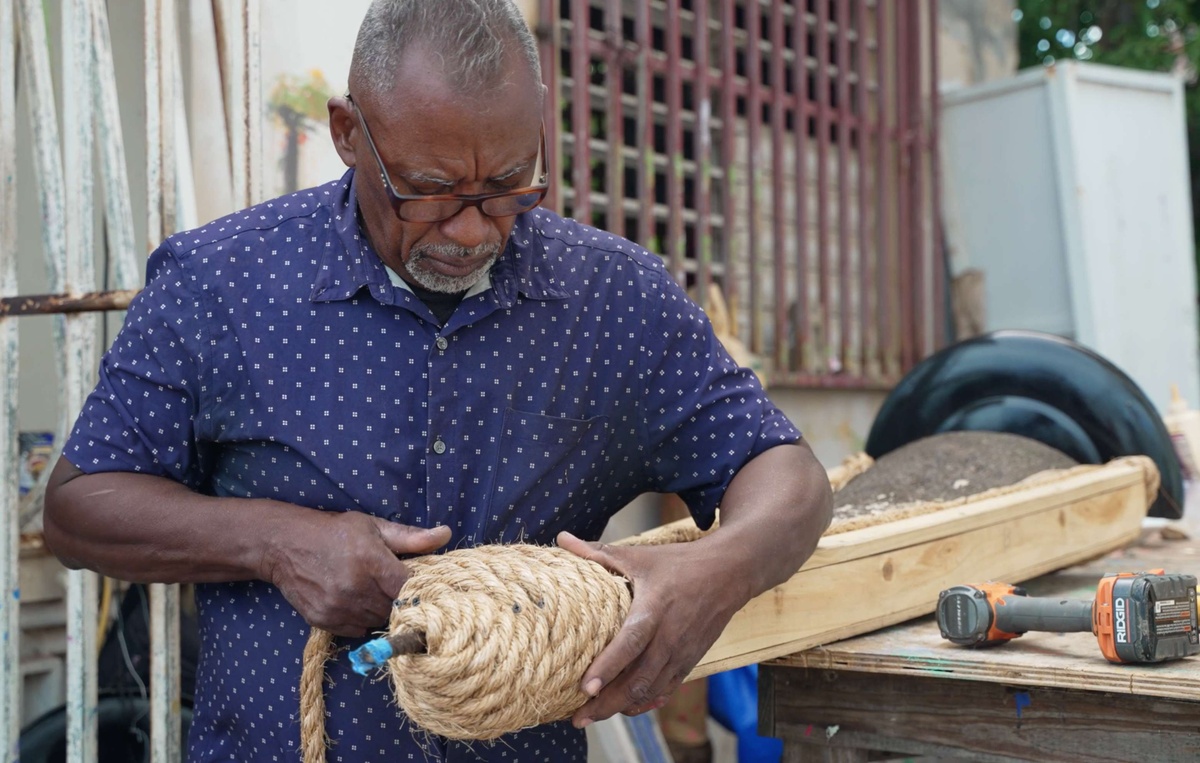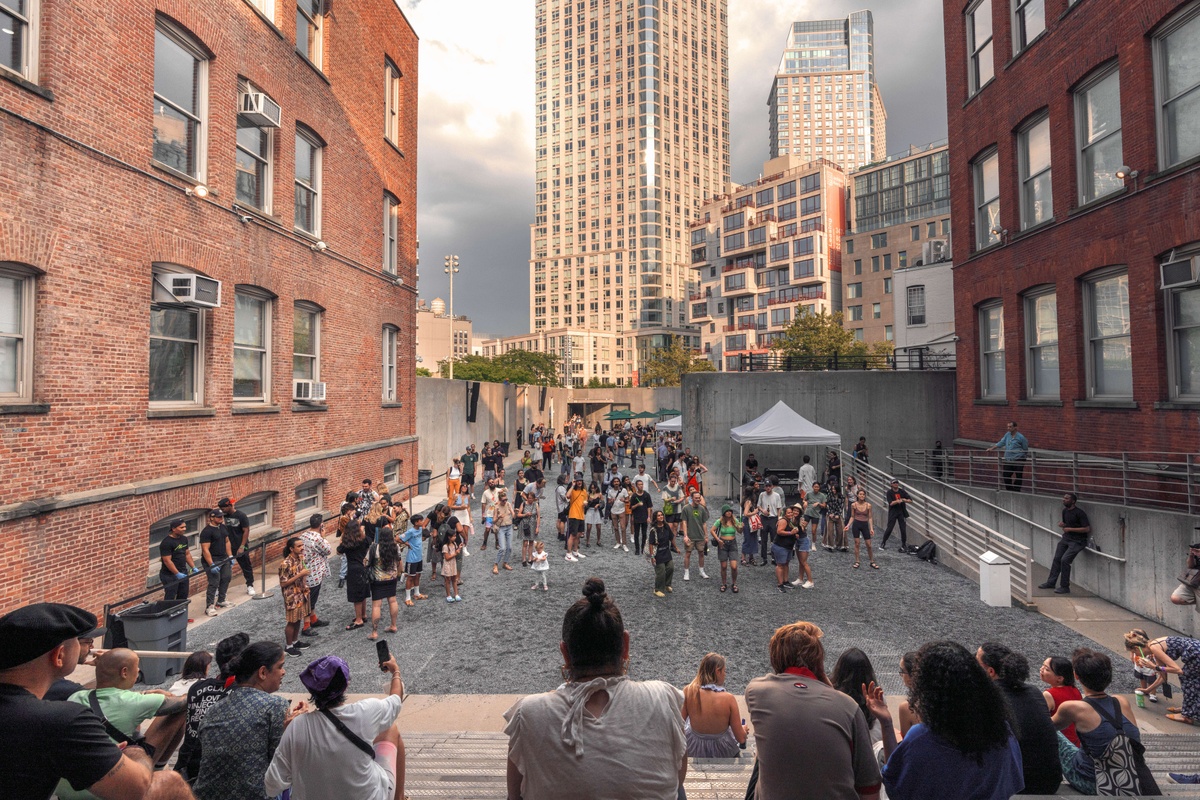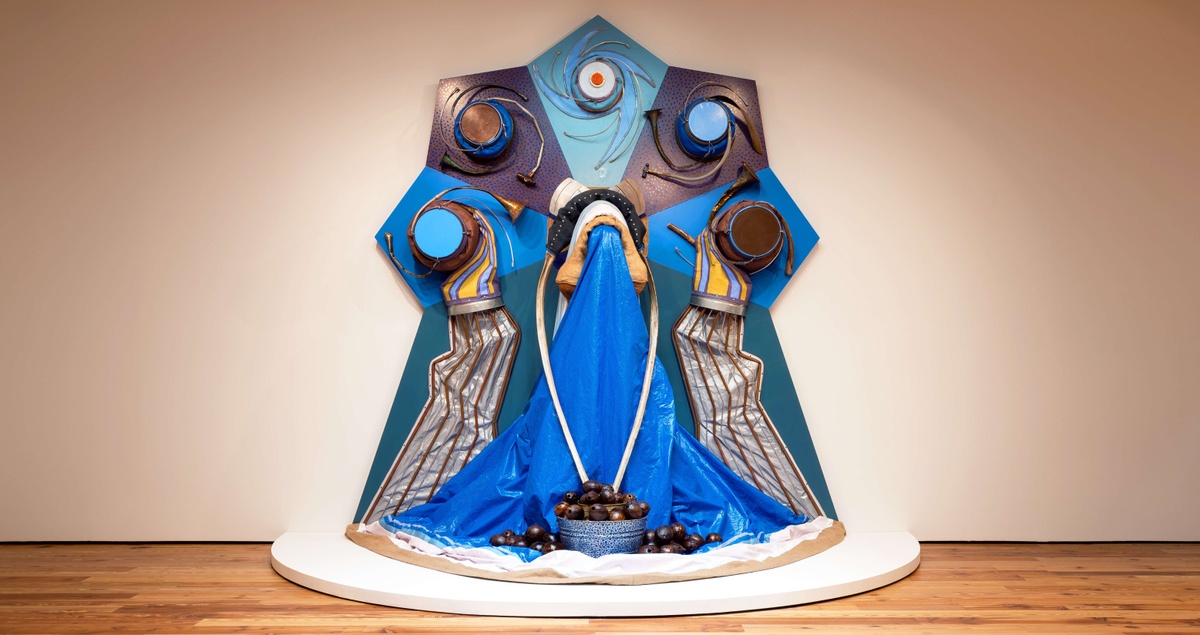Daniel Lind-Ramos Audio Guide
- Audio

English Audio Guide
:
EL Viejo Griot
El Viejo Griot: the one that knows stories. It comes from very old traditions. Like in Western Africa, there were many griots, so that’s the reason why the manifestation of El Viejo de Loíza. I wanted to put it in the context of somebody that’s going to tell its stories.
It’s inspired by a personage from the Fiesta de Loíza. When I was a child, I used to dress myself as El Viejo to participate in the procession of the carnival. And the Viejo could be many things. It could be a musician, could be a storyteller, it could be a medicine man. So it is very open, personalized, I would say. And I like that.
For this show, that assemblage with that title, you could find it right there, the first piece that I would like people to see, because there the Viejo is the storyteller. He will be telling a story through the show with different works.
I wanted to recreate, symbolize, the mangrove and the attitude of a community defending its surroundings. I have a lot of friends from Piñones, and in Piñones, there are a lot of mangroves. Most of those people are descendants of many people that used to make their earning cutting wood. And they earned their living like that, but they didn’t destroy the mangrove. They took care of the mangrove. They mention a specific time to cut the wood so it could grow again and again. That was the idea of preserving.
And there’s the lady who used to make hogueras (bonfires). She took dry wood and picked it and then burned it and made carbón (coal), and she used to sell that. So, she earned her living from the wood of the mangrove. But she preserved it also, and there is a representation of her there. Because the way that the wood was accommodated was like this, like a triangle. So, there is a figure there, made of wood. So, that’s an homage to a community that, as sentinels, defend their territory. Sentinels of the mangrove, sentinel of the black moon. I wanted to make that link with the descendants of the Black militia that defended Puerto Rico against the English attack.
Figura Emisaria is part of a series of three assemblages that are related with the production of food. Not only to be consumed by families, but also to be sold. In Loíza, there is a tradition, culinary tradition based on plates, confection by coconut as a main ingredient. So, in my house, in many houses in the community, he was coming to find this plate. Later, many families started to develop an economy around this activity. And they not only cook for themselves, but also, they cook products to be sold. Especially this one, Figura Emisaria, is based on the experience when my neighbor, Emma Carrasquillo, a great cook, came to my studio, carrying a grater. An old grater. And she told me, “Junior,” which is the name that she used to call me, “I’m going to give you this instrument, this tool, because I am going to retire.” She was 92 years old, and I was surprised for such an important and beautiful gift. But I asked her, “Emma, how did you obtain that grater?” And she said, “It used to belong to my grandmother.” And she was at that time, 92 years old. So you could imagine how old this beautiful object was.
She also told me that once she wanted to fix it and she carried the instrument, the tool, to my uncle, who was a cabinet maker. I used to work with him. And he told her, “Please leave it like that. You shouldn’t put in a new wood.” So, she didn’t do it. So the whole materials that hold the metal are the authentic, the original one. So, I took the precious present and hung it in one of the walls of the studio. And I knew that I was going to do something with it.
Every day that I watched it. I was thinking about Emma as an emissary who brought through the object a lot of knowledge, knowledge related with the confection of plates. Food with the palm tree, tree with the coconut. But also, a lady that wanted to transmit through that object, knowledge. So, I made the assemblage called Figura Emisaria, because I remember her as an emissary that wanted me to pass that knowledge, at least through the object. At least if I put it in the content of an important object to be, not worshiped, that’s not the word, but to be observed in the context of the knowledge of the community.
Baño de Maria (Bain-marie/The Cleansing) is the title of one of my assemblages, and its name came from the technique of cooking, where two vessels are included with water. I was thinking about that title because that year when Hurricane Maria struck, there were a lot of hurricanes shown in the television besides Maria. And of course, the reason why those hurricanes appear is because of the warming of the water in the area. And as we know, warm water produces strong hurricanes. So, they attribute the invention of this cooking technique to a woman called María de Alejandria, which is Africa. And then I connected that with the place of the origin of these strong hurricanes, which is the place near the islands of Cabo Verde in Africa.
It also was calling my attention, the name María, which in the Christian tradition, is a character that protects, love, et cetera. On the other hand, María was the name of a destructive force of nature. So I was trying to deal, play with both interpretations of the name, in terms of force that destroys and the force that love. So, Baño de María (Bain-marie/The Cleansing) was the first assemblage that I started in the series of Marías. The second one, María María, I finished first, even though they both were in process at the same time. Because I needed more objects or materials, tools to go on.
The third of these Marías is called María Guabancex. I wanted to create an image that was related to the way that our ancestors in the Caribbean, or people that lived in the islands before the Europeans came, named it. And I found in a document that they used to call this force of nature Guabancex. And this force was considered a female force. So I put together María and Guabancex, trying to, again, represent the force of nature. And this one is made of a lot of pieces of material that I found around my community that were brought by the winds of the hurricanes.
And also I included a part of the house that collapsed during this event. We also covered the roof with palm tree leaves. It appeared to be a weak structure, but it was really a strong structure. Later, these structures were built with more resistant materials. The same ones that we used to use to build the roof of our wooden houses. So again, all of the materials used here in María Guabancex have something to do with the experience of the hurricane. And also there is a commentary related to the way that we construct houses in the Caribbean. Meaning that we still have to be thinking about constructing stronger structures because the event of the hurricanes happens every year.
The idea of Ambulancia (2020) [Ambulance (2020)] as an expression came when I was here in New York. The first week that they discovered a case of COVID, I was here in New York. I remember that after that week, the ambulances were almost everywhere, to exaggerate. Then, a memory came to my mind, which was the first time that I heard that striking sound. I must have been so little because my mother always asked me, how could I remember that, because I was so little? The thing is that what I felt is that I was inside a dragon. You know, children’s mind. The only thing that I experienced from this dragon was the sound of the ambulance. Those two experiences were producing images in me. Then, I’ve related the ambulance with the situation of the health system, not only the one that we know about in the world.
For example, there were not enough beds, right? And then, it was like chaos, and this ambulance with its sound was like a symbol of that. Then, the warnings through the megaphone, but the reason why these two objects are a focal point of this assemblage. Then, I started to think a lot about the end of the humans on the Earth, because by that time, the victims and the deaths were increasing in, “Wow,” rapidly. I started to think about the apocalypse because I have this early formation in the Baptist Church. I remember that part of the apocalypse where terrible images, like monsters, were brought. That’s the reason why this assemblage looks like an animal, but we don’t know which animal it is. It could be a bird. It could be a dragon. It could be an elephant. I wanted to create an image that represents a lot of things, my fears, instance of the end of the human being in the Earth, the precarious system of health that we have in the world, that cannot confront a situation like this.
Spanish Audio Guide
:
El Viejo Griot
El Viejo Griot. Mi intención con esta obra es representar una imagen que tenga que ver con el Viejo de las procesiones de las fiestas de Loíza, y entonces ponerlo en un contexto donde este viejo va a contar historias. Me gustaría que esa obra fuera la primera que se viera de forma tal que las restantes obras de alguna manera sean lo que el Viejo está contando. Así que tenemos al Viejo Griot, con una serie de bolsas con fechas relacionadas con eventos históricos, y luego las próximas obras, de alguna manera, están vinculadas a esa primera. Conceptualmente, al menos, esta fue mi intención, comenzando con la pieza que tiene que ver con la luna nueva y terminando entonces con una pieza que tiene que ver con la experiencia global del COVID. Y luego terminamos otra vez en la primera pieza, que es el Viejo Griot, haciendo entonces el recorrido de la exposición y también el recorrido del relato del Viejo Griot.
Centinelas de la Luna Negra. Ese es otro ensamblaje que quisiera hacer, relacionado con la comunidad de Piñones, y específicamente la comunidad que vivía, o vive, cerca del mangle. A mis manos llegó una tesis doctoral de un amigo, el Dr. Juan Giusti, y esa tesis estuvo basada en su investigación con relación a los trabajadores y trabajadoras en torno al manglar. Me resultó fascinante porque desde el punto de vista mío, el manglar es bien importante, no solamente desde el punto de vista mío, sino desde el punto de vida de todo el que sabe la importancia del manglar con relación al ambiente. Una vez leo la tesis, decido comenzar un ensamblaje, más rindiéndole homenaje, a ese sector que, aunque su sustento venía del consumo, venía del corte de la madera, ya sea para hacer carbón, para vender a los que tenían estufas, cortar madera para crear los rieles de las centrales azucareras. Pero el punto es el siguiente: estas comunidades, consciente de la importancia del manglar, no devastaban el área. Simplemente, cortaban durante la luna negra, o luna nueva. La decisión era la siguiente: que si corta en ese periodo, el mangle retoñaba mejor. Por lo tanto, había una consciencia de la importancia del mangle y había una consciencia de proteger el mangle, usar de manera sabia lo que el mangle proveía, pero cuidándolo. Y eso es prácticamente lo que genera esta imagen. Todavía en ese sector existe esa conciencia y es común ver como grupos están sembrando tallos de mangle para que este crezca. La comunidad de Piñones [inaudible] en esa dirección, bajo el liderato de mujeres. Así que en este ensamblaje van a ver esa referencia a lo femenino con relación a la organización que conlleve la protección del mangle. También, hay una referencia a los antiguos habitantes de Loíza en general, y de Piñones en específico, y específicamente a los que pertenecieron a la milicia negra del partido de Loíza, quienes en el 1797 participaron en los combates contra la intención de los Ingleses de conquistar la isla. Todo eso está de alguna manera simbólica, obviamente, porque mi intención no es literalmente representar un mangle, pero en ese nivel de estética y abstracción hay una intención de simbolizar, a través del símbolo, de apuntar hacia esa situación.
Para mi los objetos están cargados de experiencias, ya sean personales, ya sean colectivos. Y esa carga a mi me interesa explorarla en términos visuales, la carga del objeto. Me encuentro cómodo usando encontrados, objetos que me regalan, como la vecina. Que ya una vez estaban consciente de que trabajaba con objetos, o los que pasan por allí. Muchos pasan y los dejan, los ponen para que yo los use. Pero yo siempre les pregunto si tengo la oportunidad sobre la historia del objeto, porque también eso me da ideas. Y me conecto mucho más con el porque mientras más estoy con ese material, más ideas surgen. Los que más fuerza tienen obviamente son los objetos personales. Luego los de la comunidad y así sucesivamente, el país, la región y al final, lo humano porque ¡wow!, vivimos acompañados de objetos y cada uno de ellos tiene una historia. Esa es la fuerza del objeto y lo que me provoca. La vecina, Emma Carrasquillo, que se iba a retirar, tenía 92 años. Una de las grandes cocineras de Puerto Rico, era parte de la Jueyada, que hacía la Iglesia Bautista aquí. Y venía gente a comer de la mano de Emma Carrasquillo. Ella llegó un día al taller, yo estoy trabajando abajo, con un guayo y me dice “Junior, te voy a regalar este guayo porque yo sé que tú vas a hacer algo con el y yo me voy a retirar”. Cuando yo veo el guayo es el guayo más grande que jamás yo he visto en mi vida. Un metal bien raro. Y yo le digo “Emma, ¿quién le regaló este guayo a usted?” Y dice Emma, que tiene 92 años “mi abuela”. Entonces, ¿cuántos años tenía ese objeto? Y yo lo que vi en el guayo fue una secuencia de todas esas grandes cocineras y cocineros de Loíza representadas en ese objeto. Y como mi madre y mi abuela también eran grandes cocineras, pues entonces fue bien fácil rendirles un homenaje a estas trabajadoras y trabajadores de Loíza y del mundo en general que son cocineros a través de un objeto. De un objeto que yo me identifico mucho con el. Y de ahí surgió Figura Emisaria, porque Emma llega como una emisaria con un objeto que para mi está lleno de conocimiento. Y me lo da a mi con una responsabilidad. Ese es el poder del objeto. Toda esa carga que tiene de memoria. El cuido del objeto es el cuido de la memoria, diría yo.
María, antes de asociar a María con la catástrofe, la asociaba con el amor, no? El amor de la madre al hijo, el amor familiar, etc. Y algo que me llamó la atención es el nombre que le otorgan a esta fuerza destructora de la naturaleza. Bueno existen las fuerzas creadoras y las destructoras. Ahí fue que empecé a desarrollar la serie.
La primera, Baño de María, tiene que ver con esa información que nos llega en relación al calentamiento global. El baño de María, como saben ustedes, es un recipiente de agua en otro recipiente. Entonces eso sí es el calentamiento de las aguas y el poder del huracán. María está preparando una tormenta. Hay una María de Alejandría a quien le atribuyen haber inventado el baño de María. Y eso es África. Pero en África también, en esa área de las islas en África occidental, se forman los huracanes con fuerza. Así que todas esas asociaciones estaban en esa primera obra. Y ahí incorporó entonces el toldo de FEMA, que se ha convertido prácticamente en un símbolo de las catástrofes y de la ayuda, además cargado políticamente por la relación de Puerto Rico con los Estados Unidos. Surge entonces la segunda que es María María. Esa se acerca mucho más al ícono de la María cristiana. Es como una imagen protectora, que da paz, que ayuda mentalmente a la gente, etc. Y luego está María Guabancex, una fuerza destructora de la naturaleza que envía a sus emisarios, entre ellos el trueno y el rayo avisando que vengo. Pero que luego de destruir, entonces renace la vegetación, todo cambia, etc.
Y tengo María de los Sustentos, y esa tiene que ver con observar cómo la gente después del huracán no espera, simplemente comienza la reconstrucción. Empiezan ayudando a los vecinos, a quien pueden, no esperan por las autoridades. Entonces, aflora el conocimiento ancestral. Todo ese conocimiento que tenemos, que no tiene que ver con la existencia de la electricidad, por ejemplo, la comodidad. Es la cosa de la supervivencia, ¿no? ¿Qué vamos a hacer ahora? ¿Nos vamos a quedar aquí a morir o vamos a meter mano, como decimos? Y esa es la María fuerte, la María que ayuda. Ese sería brevemente el relato de Las Tres Marías.
Este ensamblaje está inspirado en varias experiencias relacionadas con el COVID. Yo estaba en Nueva York cuando se identificó la primera víctima del COVID. Y luego, la próxima semana, fue increíble como se incrementaron las víctimas. Y un sonido recurrente durante este tiempo lo fue el sonido de la sirena, la sirena de la ambulancia. De momento, ese continuo sonido me recordó una experiencia de mi niñez: me encuentro yo dentro de una ambulancia (lo supe después), pero en mi ignorancia, yo pensé que estaba dentro de un dragón que estaba gritando. Y luego, más tarde en la vida, se lo comentaba a mi madre, y ella me preguntaba que cómo yo podía recordar eso. Pero saben ustedes que cuando uno es niño, esas experiencias así de significativas, esos traumas, se recuerdan para toda la vida. Así que en el desarrollo de esta imagen estaban esas dos experiencias: la más inmediata, la que tenía que ver con la experiencia del COVID terrible, y también con mi primera experiencia con el sonido de una ambulancia. Luego siguieron apareciendo otras imágenes relacionadas, por ejemplo, con el colapso del sistema de salud, no solamente en nuestros respectivos países, sino en el mundo en general. O sea, el mundo no estaba preparado para una pandemia de esta magnitud. Las personas recurrieron entonces a la inventiva, eso fue algo que también me impresionó, que también lo vinculo con la experiencia después de un huracán cuando las personas hacen. La inventiva se dio específicamente, o sea donde más la ví específicamente, fue en la confección de máscaras. Otra imagen que asocio con ese momento es las personas entubadas, es como si se hubiese planteado una estética relacionada con el tubo, con el entubamiento. Es increíble la cantidad de imágenes donde veíamos los tubos que tienen que ver con la transmisión de oxígeno, etc. Así que, todo esto de alguna manera está planteado, o implícito, en esta imagen de la ambulancia. Y también, algo que quise plantear es cómo, en esos momentos cruciales, los seres humanos echan mano de lo que sea, tanto en términos físicos, tanto en términos espirituales. Por ejemplo, hay un señalamiento que tiene que ver con la sanación, y tiene que ver también con como sistemas espirituales, dos religiones, representan el sanar. No voy a ser específico, no voy a señalar qué, ni donde en la imagen, porque mi interés también es que los espectadores, de alguna manera, basado en sus experiencias, construyan el significado o reaccionen a ella espontáneamente. Pero nada, en fin, Ambulancia se refiere a esa miseria, a esa precariedad que se dio durante el COVID, donde todos, prácticamente, estábamos asustados y sin fe. De ahí el tono apocalíptico que puede producir esta imagen, donde intenté de alguna manera plantear lo terrible de esa experiencia.
Por alguna razón tal vez burocrática, las ayudas importantes y necesarias llegan… no llegan cuando tienen que llegar. Y tal vez se ha tomado conciencia de eso. Ya está arraigado en nosotros, en el ser humano, diría yo. Y es una cuestión de supervivencia. Ya llegará después la ayuda, pero ¿y ahora? ¿Nos vamos a quedar sin hacer nada? Es una cuestión instintiva y de proteger al otro, no solamente a uno. Y en ese momento lo fascinante es que no necesariamente son familiares de usted, sino gente. Son gente y si hay que darle la mano, uno la da, como se la pueden dar a uno. Históricamente ha sido así, las instituciones siempre llegan después, las ayudas siempre llegan después o nunca llegan aunque sean prometidas. Se ha desarrollado ese sentimiento, de no esperemos, vamos a hacerlo nosotros mismos. Vamos a colaborar, vamos a ser solidarios con el otro. Y esa es una de las cosas bellas que arroja la catástrofe. Ya ahí no hay nombre ni apellido, sino personas, seres humanos. Y tal vez a eso es que le canto, más que la crítica a la institución. Eso ya lo sabemos, y siempre se repite. Viene un problema, como los huracanes, se habla de que vamos a arreglar tal cosa para que la próxima vez que suceda estemos prevenidos. Pero prácticamente volvemos a lo mismo y yo diría que el avance lo hace la comunidad, la gente misma en espera.
Una gran oportunidad de poner un cuerpo de obras en un mismo lugar, que tiene que ver con mis investigaciones, tiene que ver con mis búsquedas, mis propuestas. Pero a la misma vez, tiene que ver con una actitud en relación a una comunidad, que quiere vivir junta y en armonía con la naturaleza. Una comunidad que no quiere olvidar. Una comunidad que al final, cree en el ser humano, independientemente de donde se encuentre. Y es también importante mencionar que aunque estas piezas se inspiran en un lugar específico como Loíza, pero yo estoy claro de que detrás de esa fachada está lo global, lo universal. Y eso a mi me interesa mucho. Según yo puedo apreciar expresiones de otros países que yo no vivo, pero siempre uno encuentra ese espíritu humano detrás y al final eso es lo que me interesa: compartir historias particulares pero dentro de un contexto del ser humano.




